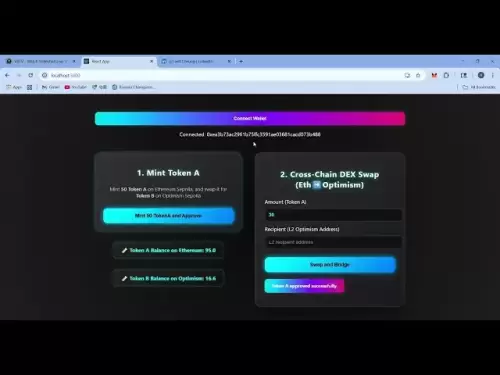-
 Bitcoin
Bitcoin $109,459.7682
2.44% -
 Ethereum
Ethereum $2,598.6052
6.29% -
 Tether USDt
Tether USDt $1.0003
0.00% -
 XRP
XRP $2.2734
3.95% -
 BNB
BNB $661.4886
1.58% -
 Solana
Solana $155.4825
4.35% -
 USDC
USDC $0.9999
-0.02% -
 TRON
TRON $0.2838
1.04% -
 Dogecoin
Dogecoin $0.1740
8.25% -
 Cardano
Cardano $0.6047
9.04% -
 Hyperliquid
Hyperliquid $40.2302
6.50% -
 Sui
Sui $2.9863
10.05% -
 Bitcoin Cash
Bitcoin Cash $509.5786
0.60% -
 Chainlink
Chainlink $13.8156
6.03% -
 UNUS SED LEO
UNUS SED LEO $9.0142
0.69% -
 Avalanche
Avalanche $19.0337
8.68% -
 Stellar
Stellar $0.2438
5.17% -
 Toncoin
Toncoin $2.9012
3.59% -
 Shiba Inu
Shiba Inu $0.0...01210
6.20% -
 Litecoin
Litecoin $90.0882
7.05% -
 Hedera
Hedera $0.1597
8.53% -
 Monero
Monero $326.3340
2.88% -
 Polkadot
Polkadot $3.6365
9.32% -
 Bitget Token
Bitget Token $4.6162
2.72% -
 Dai
Dai $1.0001
0.00% -
 Ethena USDe
Ethena USDe $1.0002
-0.01% -
 Uniswap
Uniswap $7.6403
10.47% -
 Pepe
Pepe $0.0...01060
12.03% -
 Aave
Aave $281.3664
7.56% -
 Pi
Pi $0.4992
1.76%
How to hedge Gate.io leverage trading
Hedging on Gate.io's leverage trading platform allows traders to mitigate potential losses by taking opposing positions in related markets, thereby reducing risk while enhancing trading flexibility and profitability.
Nov 14, 2024 at 03:00 pm

Hedging Gate.io Leverage Trading: A Comprehensive Guide
Introduction
Leverage trading on Gate.io is a potent tool that can magnify both profits and losses. However, this increased risk can be mitigated through effective hedging strategies. This guide will provide a comprehensive overview of hedging techniques tailored specifically for Gate.io leverage trading.
Understanding Hedging
Hedging is a risk management strategy that involves taking an opposing position in a related market in order to offset potential losses. In the context of leverage trading, hedging can involve opening positions that are both in the same direction as the primary trade and in the opposite direction.
Benefits of Hedging
Hedging offers several key benefits for leverage traders:
- Reduced Risk: Hedging helps to reduce the risk of large losses by offsetting potential price fluctuations.
- Increased Trading Flexibility: Hedging allows traders to maintain open positions while minimizing downside risk, providing greater flexibility in trading strategies.
- Enhanced Profitability: Hedging can potentially enhance profitability by locking in partial gains and reducing the impact of adverse market movements.
Types of Hedging Strategies
1. Symmetrical Hedging:
- This strategy involves opening an equal but opposite position to the primary trade, effectively neutralizing the exposure to price fluctuations.
- Symmetrical hedging provides a high degree of protection but limits potential profits, as gains are offset by losses.
2. Delta Hedging:
- This strategy involves adjusting the size of the hedge position to match the delta of the primary trade, reducing the exposure to price changes but allowing for some directional bias.
- Delta hedging requires ongoing adjustments and monitoring, making it more suitable for advanced traders.
3. Cross-Currency Hedging:
- This strategy involves opening a hedge position in a currency pair that has a negative correlation with the primary trade's underlying asset.
- Cross-currency hedging mitigates the impact of currency fluctuations, but requires careful selection of the hedging currency pair.
4. Options Hedging:
- This strategy utilizes options contracts to hedge against potential losses. Options can be used to limit downside risk while preserving upside potential.
- Options hedging is more complex and requires a deep understanding of options trading.
5. Contract-for-Difference (CFD) Hedging:
- This strategy involves opening a CFD position on the same underlying asset but in the opposite direction of the primary trade.
- CFD hedging is similar to symmetrical hedging, but offers the advantage of not requiring the physical delivery of the underlying asset.
Implementation Steps
1. Determine Risk Tolerance:
- Assess your risk tolerance and determine the maximum loss you are willing to incur. This will guide the size and type of hedge position you implement.
2. Choose a Hedging Strategy:
- Select the hedging strategy that best suits your trading objectives and risk tolerance. Consider the level of protection and flexibility desired.
3. Calculate Hedge Position Size:
- Calculate the appropriate size of the hedge position based on the chosen strategy. This may involve using delta hedging ratios or options premiums.
4. Monitor and Adjust:
- Continuously monitor market conditions and adjust the hedge position as necessary to maintain the desired level of risk exposure. This involves regular updates to delta values or options hedging ratios.
5. Close Out Hedges:
- Close out the hedge position when the original trade is closed or when the risk tolerance has changed. Avoid holding hedges indefinitely to prevent unnecessary costs.
Disclaimer:info@kdj.com
The information provided is not trading advice. kdj.com does not assume any responsibility for any investments made based on the information provided in this article. Cryptocurrencies are highly volatile and it is highly recommended that you invest with caution after thorough research!
If you believe that the content used on this website infringes your copyright, please contact us immediately (info@kdj.com) and we will delete it promptly.
- Coinbase's Crypto Conquest: The Liquifi Acquisition and the Token Revolution
- 2025-07-03 16:30:12
- Neo Pepe Coin: Can This Meme Coin Make Waves in the 2025 Crypto Market?
- 2025-07-03 16:50:12
- Toncoin, Dogecoin, and Shiba Inu: A Wild Ride in the Crypto Zoo
- 2025-07-03 16:30:12
- AllScale: Stablecoin Solutions Empowering Small Businesses – A New York Perspective
- 2025-07-03 16:35:12
- Neo Pepe Coin Presale: Is This Meme Coin a Serious Crypto Investment?
- 2025-07-03 17:10:11
- Memecoins to Buy in July 2025: Riding the Hype or Investing Wisely?
- 2025-07-03 17:10:11
Related knowledge

How to identify the contract value range in combination with the market profile?
Jul 02,2025 at 10:56pm
Understanding the Market ProfileTo effectively identify the contract value range in combination with the market profile, it's essential to first understand what each concept entails. The market profile is a framework that helps traders visualize how price and time interact across a given period, typically a trading day or session. It provides insights i...

How to use the price slope to filter the false breakthrough signal of the contract?
Jun 20,2025 at 06:56pm
Understanding the Concept of Price Slope in Contract TradingIn contract trading, especially within cryptocurrency derivatives markets, price slope refers to the rate at which the price changes over a specific time period. It helps traders assess the strength and sustainability of a trend. A steep slope may indicate strong momentum, while a shallow slope...

How to determine the expected volatility of the contract through the volatility cone?
Jun 19,2025 at 12:28pm
Understanding the Basics of Volatility in Cryptocurrency ContractsIn the realm of cryptocurrency trading, volatility is a key metric that traders use to assess potential risk and reward. When dealing with futures contracts, understanding how volatile an asset might become over time is crucial for position sizing, risk management, and strategy developmen...

How to formulate a contract intraday trading plan in combination with the pivot point system?
Jun 21,2025 at 03:42pm
Understanding the Basics of Pivot Points in Cryptocurrency TradingPivot points are technical analysis tools used by traders to identify potential support and resistance levels. These levels are calculated using the previous day's high, low, and closing prices. In the context of cryptocurrency trading, where markets operate 24/7, pivot points help trader...

How to adjust the contract position ratio through the price fluctuation entropy?
Jun 22,2025 at 11:42am
Understanding Price Fluctuation Entropy in Cryptocurrency ContractsIn the world of cryptocurrency futures trading, price fluctuation entropy is a relatively new concept used to measure market volatility and uncertainty. It derives from information theory, where entropy refers to the degree of randomness or unpredictability in a system. In crypto contrac...

How to use the volume swing indicator to predict the contract volume-price divergence?
Jun 18,2025 at 11:42pm
Understanding the Volume Swing IndicatorThe volume swing indicator is a technical analysis tool used primarily in cryptocurrency trading to evaluate changes in volume over time. Unlike price-based indicators, this metric focuses solely on trading volume, which can provide early signals about potential market reversals or continuations. The key idea behi...

How to identify the contract value range in combination with the market profile?
Jul 02,2025 at 10:56pm
Understanding the Market ProfileTo effectively identify the contract value range in combination with the market profile, it's essential to first understand what each concept entails. The market profile is a framework that helps traders visualize how price and time interact across a given period, typically a trading day or session. It provides insights i...

How to use the price slope to filter the false breakthrough signal of the contract?
Jun 20,2025 at 06:56pm
Understanding the Concept of Price Slope in Contract TradingIn contract trading, especially within cryptocurrency derivatives markets, price slope refers to the rate at which the price changes over a specific time period. It helps traders assess the strength and sustainability of a trend. A steep slope may indicate strong momentum, while a shallow slope...

How to determine the expected volatility of the contract through the volatility cone?
Jun 19,2025 at 12:28pm
Understanding the Basics of Volatility in Cryptocurrency ContractsIn the realm of cryptocurrency trading, volatility is a key metric that traders use to assess potential risk and reward. When dealing with futures contracts, understanding how volatile an asset might become over time is crucial for position sizing, risk management, and strategy developmen...

How to formulate a contract intraday trading plan in combination with the pivot point system?
Jun 21,2025 at 03:42pm
Understanding the Basics of Pivot Points in Cryptocurrency TradingPivot points are technical analysis tools used by traders to identify potential support and resistance levels. These levels are calculated using the previous day's high, low, and closing prices. In the context of cryptocurrency trading, where markets operate 24/7, pivot points help trader...

How to adjust the contract position ratio through the price fluctuation entropy?
Jun 22,2025 at 11:42am
Understanding Price Fluctuation Entropy in Cryptocurrency ContractsIn the world of cryptocurrency futures trading, price fluctuation entropy is a relatively new concept used to measure market volatility and uncertainty. It derives from information theory, where entropy refers to the degree of randomness or unpredictability in a system. In crypto contrac...

How to use the volume swing indicator to predict the contract volume-price divergence?
Jun 18,2025 at 11:42pm
Understanding the Volume Swing IndicatorThe volume swing indicator is a technical analysis tool used primarily in cryptocurrency trading to evaluate changes in volume over time. Unlike price-based indicators, this metric focuses solely on trading volume, which can provide early signals about potential market reversals or continuations. The key idea behi...
See all articles

























































































